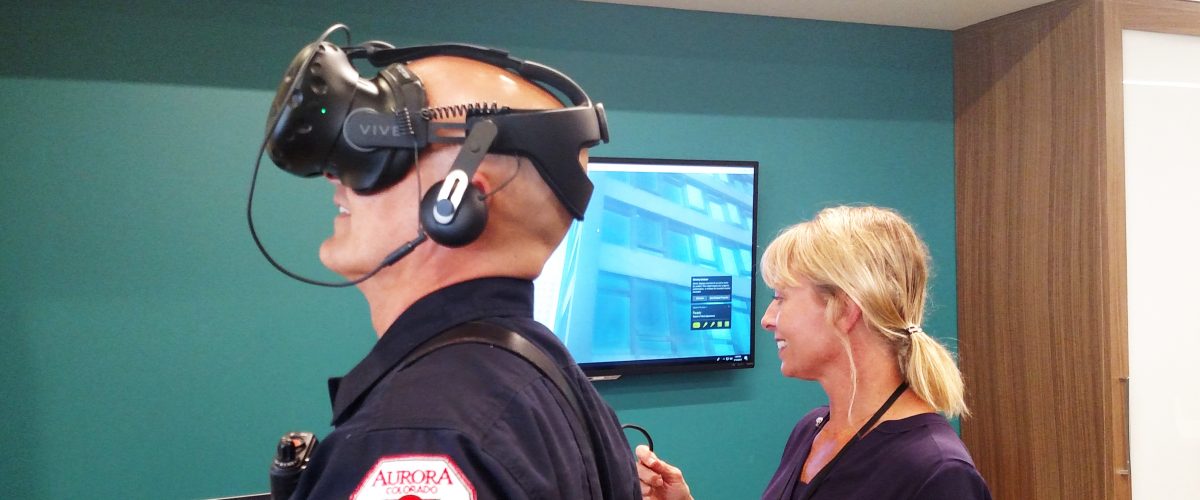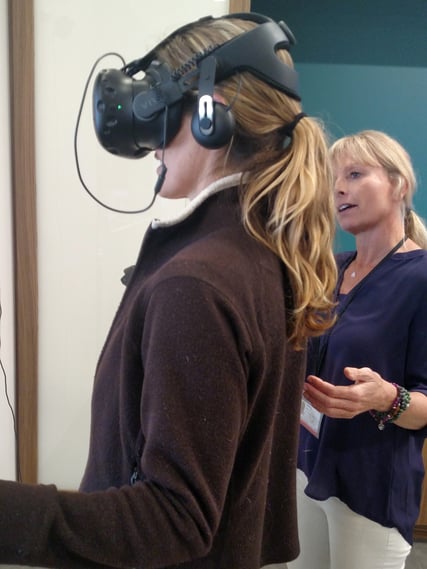 Editor’s note: This is the first in a periodic series of CU Anschutz Today articles focused on the potential of virtual reality technology in the medical setting. With its unique attributes, the University of Colorado Anschutz Medical Campus could lead the way in ensuring responsible and effective implementation of the gaming technology in health care.
Editor’s note: This is the first in a periodic series of CU Anschutz Today articles focused on the potential of virtual reality technology in the medical setting. With its unique attributes, the University of Colorado Anschutz Medical Campus could lead the way in ensuring responsible and effective implementation of the gaming technology in health care.
A nervous heart patient waiting for surgery suddenly finds herself immersed in an ocean of aqua blue. As she slowly treads the warm water, sparkling from the sun’s reflection, a pod of dolphins emerges, playfully swimming and circling her in the gently rolling sea. Her breathing slows. Her heart rate drops, as her meditative escape puts her in a better state for the surgery ahead.
Whether transporting anxious patients from hospital beds to sunny beaches, testing operating-room staff with explosive fires, or treating first-responders for post-traumatic stress disorder (PTSD), researchers on the University of Colorado Anschutz Medical Campus are launching pilot programs aimed at bringing virtual reality (VR) to the forefront of medicine.
Matt Vogl, NMHIC director, left, and Walter Greenleaf, a pioneer in virtual reality in medicine, take a break during a meeting at Facebook headquarters. The two aim to lead VR innovation in health care.
As interest in the medical uses of the gaming technology grows, with ideas bubbling up not just inside CU Anschutz’s walls but in most major medical centers across the country, some experts predict the uniquely-positioned Aurora campus could lead the way in ushering in a potentially transformative era that takes VR far beyond a teenage pastime.
“This new wave of technology is going to give us the tools to advance otherwise very difficult problems that we haven’t had a lot of success addressing,” said Walter Greenleaf, PhD, one of the most-noted experts in the field, who joined the CU Anschutz Medical Campus last April as director of technology strategy for the National Mental Health Innovation Center (NMHIC). “But we have a lot of work to do.”
‘More like the wild West’
A Stanford University visiting scholar, Greenleaf said CU Anschutz caught his eye because of its top experts, rigorous research, leading-edge innovation centers and ability to transfer its academic work directly to the clinical setting. Its attributes make the university the “right place to start” in advancing research while simultaneously diverting a path that could quickly lead in a dangerous direction, he said.
Although VR’s potential has been known for years, with Greenleaf pioneering the study of its medical uses in the early ‘80s, plummeting equipment prices spurred the recent rush to enter health care and other fields.
Hungry for ways to recoup billions of dollars spent in gaming development, companies are jumping in as technologists, game designers or computer scientists, Greenleaf said. “And they often don’t take the time or even know how to do a validation study,” he said. “I’m worried that there is some harm that could be done.”
Laura McGladrey, NP, a specialist in psychiatry and emergency medicine, tries VR while discussing its potential in the field with NMHIC's Rhonda Kelly.
In a “perfect world,” the hundreds of companies scrambling to be the “first to plant their flag” would slow down, work with the experts and make sure their products were truly effective and research-based, said Matt Vogl, MPH, executive director of the NMHIC. “But right now, it’s more like the wild West.”
‘Not a magic wand’
While VR programs for swimming with dolphins might be innocuous enough, targeting the public with platforms using war scenes from Afghanistan as exposure therapy for veterans or a virtual Paris nightclub to treat mass-shooting survivors would be dangerous, Greenleaf said. A rushed, poorly-designed program, combined with no expert supervision, could re-traumatize a person, he said.
Some questionable programs already exist, targeting the public online with phobia treatments, Vogl said. “It’s basically do-it-yourself-phobia therapy, and there is not a shred of data saying that you can do exposure therapy on yourself,” said Vogl, who founded the center because of the need for better and more accessible mental health care.
Finding that VR could fill the mental-health needs community members were expressing to his staff, Vogl and his center are working on pilot programs in area treatment centers, doctors’ offices, fire departments and more. “But it’s not a magic wand. It’s a tool,” Vogl said, adding that probably less than 30 percent of time spent in a VR session involves VR, with the rest focused on traditional therapy with a trained mental-health expert.
‘By far our best partner’
By combining forces with the multiple innovation centers on the CU Anschutz Medical Campus and its two major hospitals, CU Anschutz staff hope to steer the implementation of VR technology for medical uses in a disciplined way.
Industry-based studies are always questionable, said Gali Baler, lead venture analyst for CU Innovations. “Here, we can really ensure that they are performed in a rigorous fashion and that they actually get outcomes and data that are meaningful both for the clinicians and the outside company,” Baler said. “With our partnerships with the hospitals, we can then test and deploy the technology in a clinical setting.”
“The team at CU has been by far our best partner. (It has) been incredibly useful in introducing us to organizations that are interested in providing VR and giving us fantastic feedback.” – Limbix CEO Ben Lewis
With due diligence, CU’s innovation centers weed out companies that fail its standards. Vogl’s center, for instance, has partnered with Limbix, a Palo Alto, Calif., company focused solely on mental-health VR applications.
Limbix employs behavioral experts and works closely with CU Anschutz providers to study, fine-tune and implement platforms that target everything from fear of flying to PTSD, a chief cause of suicide in war veterans and first-responders.
“The team at CU has been by far our best partner,” said Limbix CEO Ben Lewis. “Matt and his team have been incredibly useful in introducing us to organizations that are interested in providing VR and giving us fantastic feedback,” Lewis said. Vogl’s NMHIC links reputable companies with professional providers, monitoring for and advising on effectiveness and keeping products out of laypersons’ hands.
“We need to show the right way to do it before the junk systems are developed, get headlines and cause problems. We need to stay ahead of the curve.” – Walter Greenleaf, PhD
‘We are not clinicians’
“Quality matters,” said Cole Sandau, president of the Optera Group in Westminster, which is working with CU Innovations in developing VR platforms for the hospitals on the CU Anschutz Medical Campus. Rushing to development will lead to failure, said Sandau, whose company focuses on health products and has worked with big industry names, such as Novartis and Mount Sinai Hospital.
Collaborating with providers at University of Colorado Hospital, Sandau’s company hopes to test a virtual training program that places OR staff members in a fire setting, which they must then extinguish while following set protocol. By eliminating the more dangerous and costly need of simulating an incident by lighting a "patient" on fire, the program can also make training more accessible and boost compliance.
“We just spent four months trying to figure out a set of hand controls that don’t cognitively overload the user,” said Sandau, who wants to create the standard for health care controllers for the industry. “You’ll drive everybody crazy if every VR app behaves differently,” he said, comparing the frustration to switching from a PC to a Mac.
Clunky, inconsistent products that fail realistic immersion of users in a 3-D virtual environment cannot effectively serve the medical community’s needs, Sandau said. And working side by side with medical providers is imperative for meeting objectives and being clinically accurate, he said. “We are very good developers, and we understand health care, but we are not clinicians.”
‘Only if it’s done right’
Many other applications are being investigated on campus and nearing pilot-program status, including using VR with Children’s Hospital Colorado patients pre- and post-procedure as a means of curbing anxiety and reducing pain medicine reliance during recovery. Also in conjunction with the pediatric hospital, Sandau’s company is developing an educational VR experience for parent caregivers.
Already powerful, VR will improve even more in the next two years or so and could change the face of health care, Greenleaf said. On the mental health side, the technology is poised to help victims of major health crises, such as opioid addiction, mass-shootings, national disasters and depression, Greenleaf said. In all medical areas, it can improve access and aid an overburdened system headed for trouble if issues aren’t addressed, he said.
“In my opinion, technology is the answer to addressing these issues,” he said. “But only if it’s done right. There is great potential and great concern. I’m glad we are the leaders. We need to show the right way to do it before the junk systems are developed, get headlines and cause problems. We need to stay ahead of the curve.”
TO EXPERIENCE VR
Because experiencing virtual reality is the only way to truly understand its power, Matt Vogl, director of the National Mental Health Innovation Center, invites anyone who wants to dive into a virtual world to call his office and schedule an experience: 303-724-9955.






